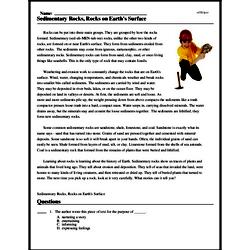Sedimentary Rocks, Rocks on Earth's Surface
Rocks can be put into three main groups. They are grouped by how the rocks formed. Sedimentary (sed-uh-MEN-tuh-ree) rocks, unlike the other two kinds of rocks, are formed on or near Earth's surface. They form from sediments eroded from other rocks. The sediments may come from igneous, metamorphic, or other sedimentary rocks. Sedimentary rocks can form from sand, clay, mud, or once-living things like seashells. This is the only type of rock that may contain fossils.
Weathering and erosion work to constantly change the rocks that are on Earth's surface. Wind, water, changing temperatures, and chemicals weather and break rocks into smaller bits called sediments. The sediments are carried by wind and water. They may be deposited in river beds, lakes, or on the ocean floor. They may be deposited on land in valleys or deserts. At first, the sediments are soft and loose. As more and more sediments pile up, the weight pressing down from above compacts the sediments like a trash compactor presses loose trash into a hard, compact mass. Water seeps in, carrying dissolved minerals. The water drains away, but the minerals stay and cement the loose sediments together. The sediments are lithified; they form new sedimentary rocks.




